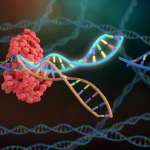By Cleo Lin
A common but deleterious mistake many sushi lovers have likely made is taking ambitious serving sizes of the Japanese root wasabi with their rolls. Unfortunately, this mistake is quickly registered after the wasabi contacts our taste receptors, manifesting in tears and a minty heat filling up the mouth. This stinging, burning sensation, commonly associated with eating wasabi, stems from its interactions with the transient receptor potential cation channel, subfamily A receptor, shortened: TRPA1 Receptor. Scientists have fondly nicknamed this receptor the “wasabi receptor” due to its sensitivity to the pungent chemicals present in hot or spicy foods like wasabi and mustard. Dubbed as the “fire alarm” of the body’s nervous system, TRPA1 excites an autonomic response within the nervous system towards chemical irritants in the environment. It also carries a mechanical response within the body as a reaction to chemical activators due to its stress sensor. When this receptor encounters harmful chemicals, more specifically a class of chemicals containing reactive electrophiles (a group that accepts electron pairs), sensations of acute pain, cold, or itchiness can be passed through the sensory system. (Julius)
Recent discoveries by scientists at the University of California, San Francisco of TRPA1’s binding mechanisms towards reactive electrophiles could lead to the next big breakthrough for anti-inflammatory pain drugs and pain medications targeted towards chronic pain. Typical receptors usually recognize a specific shape of a substrate to be activated, using a lock and key model to bind to receptors. TRPA1 forgoes this type of shape dependent binding and instead recognizes many differently shaped irritant chemicals through covalent binding interactions with their electrophiles. This makes it much more receptive to a variety of substrates that could be used to regulate pain, rather than traditional receptors that are only responsive to singularly shaped substrates. On top of recognizing foreign irritants, TRPA1 receptors can also be triggered by pain-inducing mechanical and chemical signals from within the body usually stemming from inflammation and tissue damage. (Julius) Upon activation, the TRPA1 Receptor rapidly flutters open and closed to allow ions to flow into the cell, disrupting the cells’ electrochemical gradients. As the receptor flutters open and closed, it activates a positive reinforcement loop prolonging and stabilizing its activation loop. By allowing positively charged sodium and disproportionate amounts of calcium ions to flow into the cell, this gradient change causes acute signals of pain and localized inflammation due to the calcium ions. (Julius) These findings, especially that of TRPA1’s versatile viability and ability to hold prolonged signaling, are extremely exciting for the scientific community and medicinal field. With the newfound knowledge scientists are now looking at ways to possibly hinder the induction of TRPA1 receptors in controlling pain due to chronic inflammation, as well as using the receptors for targets of new pain medications.
One such prospective new development for pain medication is currently being tested in a joint effort from researchers at the University of California, San Francisco as well as researchers from the University of Queensland. Researchers have isolated a toxin called WaTx from the Australian Black Rock Scorpion. Although the scorpion toxin WaTx triggers the wasabi receptor in the same way as other environmental and chemical pollutants, using the same sites on the receptor, it activates TRPA1 in a different way that was previously unknown. By studying WaTx’s DNA sequence and using computational in silico models, researchers at UCSF and University of Queensland were able to discover that WaTx contains a specific amino acid sequence that allows it to directly pass through TRPA1 and the plasma membrane into intracellular sites known as allosteric nexi and wedge itself in the sites. (Julius) By wedging itself into the intracellular allosteric nexi, WaTx is able to covalently bond with the receptor keeping the TRPA1 channel open. This abolishes TRPA1’s ability to actively pump calcium through the membrane resulting in overall ion levels that are high enough to trigger a pain response, but calcium levels that remain too low to cause inflammation in the area. (Julius)
Taking these results, the research team has carried out their research into in vivo experimentation. By using mustard oil which is a known activator of TRPA1 and injecting it into the paw pads of mice as a control, scientists were able to trigger pain, inflammation, swelling, and hypersensitivity to touch and temperature within the mices’ paws pads. They then measured activity along the mice’s central neuronal pain receptor pathways using electrophysiology methods such as cell patch clamp recordings to quantify their pain responses. Contrastingly, mice injected with both mustard oil and WaTx still displayed sensitivity and acute displays of pain but did not display any signs of swelling or inflammation. Through these experimental results, scientists were able to deduce that while WaTx did not numb the body to experiencing pain, it is able to reduce and mitigate inflammation in mammals.
In addition to making headway in studies of pain and inflammation, scientists have also been able to deduce the purpose of toxins like WaTx in animals such as the Australian Black Rock scorpion. Many animals use venom to paralyze or kill their prey, but WaTx seems to serve as a defense mechanism. While virtually every animal, including worms and humans, have a form of TRPA1, the researchers found that WaTx only activates specific forms of TRPA1 found in mammals. Given that black rock scorpions don’t eat mammals, it’s likely that the toxin is mainly used to ward off mammalian predators. This information is of interest to researchers who are now trying to figure out ways to reverse engineer the pathway of pain using various venoms found in natural plants and animals. By figuring out the exact pathway of pain from stimulus to sensation and perception, scientists and drug developers can have a better understanding of how to properly manage pain by targeting specific steps along its pathway.
According to a 2019 CDC census, about 25 percent of adults in the United States are currently suffering from some form of chronic pain or disorder. This equates to about 50 million US adults experiencing chronic pain on a daily basis and 20 million experiencing high impact chronic pain. (CDC) Patients suffering from these types of ailments such as various skeletal pains (arthritis, back, neck), headaches, and muscle aches often are hindered in their everyday activities both mentally and physically, dramatically decreasing their quality of life. These pains can be classified by criteria such as pathophysical mechanisms (such as nociceptive, inflammatory, or pathological pain), duration, etiology (malignant or non malignant), and anatomical position. (CDC) Through targeting TRPA1 receptors instead of traditional lock and key receptors, scientists believe that they will be able to target many common types of pain such as inflammatory nociceptive pain which can be found in tissue damage as well as neuropathic pain which can be found in nerve damage. Additionally, by using TRPA1 as a therapeutic target, researchers are hoping to diminish the medical field’s reliance on opioids which pose a high risk factor for patients and come with numerous side effects. While results have only shown promising in rodents thus far, researchers are excited about the numerous possibilities TRPA1 represents in revolutionizing the treatment of pain and inflammation for the many that suffer from its propagating effects.








